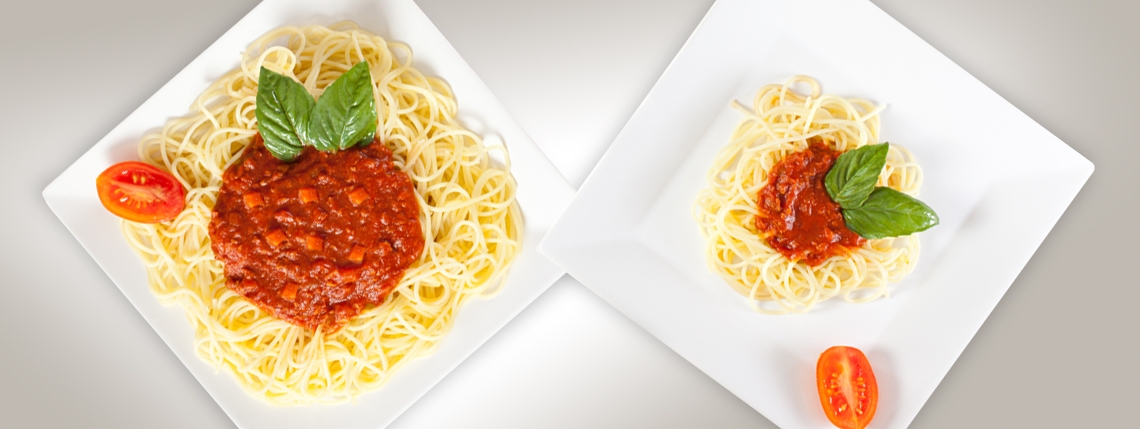Most of us probably don’t think too much about portion sizes when we eat. Typically, it depends on how hungry we feel, how much is in a pack or on a plate or what we are typically used to having. However, a healthy and balanced diet is about getting the right types of foods and drinks in the right amounts too, as Linia Patel explains.
Eating the right portion size for you
One size doesn’t fit all and this is also the case when it comes to portion sizes too. There are different methods used to advise on portion sizes. There are plate guides, hand guides, weight guides and household measurement guides1,2. No matter which guide you use, a key thing to remember is that guides are simply just that. People have different needs and, if you really want to find out your individual needs, seek support from a dietitian or a registered nutritionist. This blog simply provides a place to get started.
Recommended portion size
Knowing recommended portion sizes for commonly eaten foods can help you moderate your intake1. Here are some examples:
Food Group |
What is a portion? |
Carbohydrates |
1 medium slice of bread2-3 tablespoons of pasta or rice boiled2 egg-sized new baby potatoes3 tablespoons of cereal |
Protein |
60-90g of cooked meat (all)140g of cooked fish (all)2 eggs (120g)4 tablespoons of all beans or vegetables-based meat alternative |
Fat |
1 teaspoon of butter or spread (5g)1 teaspoon of oil (3g)1/2 standard avocado |
Dairy |
200ml milk (all) (1/3 pint)125g yogurt30g hard cheese |
Fruit and veg |
1 apple or 1 pear or 1 orange or 1 banana (80g)1 handful (10-12) grapes and berries (80g)2 plums/apricots or kiwi (80g)1 tablespoon dried fruit (30g)3 heaped tablespoons of mixed vegetables1/2 pepper/1 medium tomato |
The plate guide
Within my clinical practice I have found that clients like the plate guide as a practical reference point, as you can divide your plate into sections based on different food groups. As a rough guide for each meal, I would recommend:
- Vegetables or salad or lower glycaemic index fruit: half a plate
- High-quality protein (such as fish, poultry, eggs, plant-based protein): quarter of a plate
- Complex carbs (such as wholegrains, grains or starchy vegetables like potatoes and parsnips): quarter of a plate
- High-fat foods (including cheese, oils, butter, avocado and nut butters): half a tablespoon
Handy portion sizes
Another way to gauge appropriate portion size without getting too obsessive about weighing is to simply use your hands. Hand size usually corresponds to your body size, so smaller people who typically would require less food have smaller hands and bigger people who require more food typically have bigger hands1,2. However, of course the more active you are the more you will need. A rough guide for each meal is:
- Vegetables, salad and fruits: two fistfuls
- High-protein foods: size and thickness of your palm (cooked)
- High-carb foods: one fistful
- High-fat foods: size of your thumb
Tips to help you become portion savvy3,4,5
- Use smaller dinnerware: Evidence suggests that sizes of plates, spoons and glasses can unconsciously influence how much food someone eats. For example, using large plates can make food appear smaller, which can often lead to overeating. Simply using smaller dishes can lower the amount of food you consume.
- Don’t eat straight from the container: Family-sized packets or food served from large containers encourages overeating and less awareness of appropriate portion sizes. This is particularly true for snacks. Rather than eating snacks from the original packaging, emptying them into a smaller bowl can stop you eating more than you need. This applies to serving food as well. Rather than serving food directly from the stove, re-portion it onto plates before serving. Doing so will prevent overfilling your plate and discourage returning for seconds.
- Have soup as a starter. Results from a recent study showed that when participants in the study ate a first course of soup before a lunch entrée, they reduced their total calorie intake at lunch by 20% compared to those who didn’t eat the soup. Obviously, the type of soup you consume is key. Vegetable, broth-based soups have a low energy density and high water content, which leads the stomach to feel fuller and therefore signal to the brain that it feels fuller.
- Think about tracking your intake: Writing down all food and drink can increase awareness of the type and amount of foods you are consuming. In weight-loss studies, those who kept a food diary tended to lose more weight overall than those who didn’t. If you have weight-loss goals, keeping a food diary can be another way to keep track of your portion sizes. It also motivates you to make healthier choices and reduce your chances of overeating.
- Slow down. Science has shown that eating quickly does you no favours. Neither does eating mindlessly (i.e., in front of the TV). Therefore, sitting down to meals with no other distractions, and eating mindfully and slowly (minimum 20 minutes), can help regulate portion control and reduce your likelihood of overeating.
Good references for more information
British Nutrition Foundation (BNF) guide: https://www.nutrition.org.uk/healthyliving/find-your-balance/portionwise.html
British Dietetic Association (BDA) guide: https://www.bda.uk.com/resource/food-facts-portion-sizes.html
About the author

Linia Patel has a BSc degree in biochemistry and physiology. Since graduating in 2006, Linia has become a leading dietitian and sports nutritionist. She is currently a PhD candidate in public health. Her passion is translating nutritional science into easy-to-digest and practical advice.
References
- British Nutrition Foundation ( BNF) guide: https://www.nutrition.org.uk/healthyliving/find-your-balance/portionwise.html
- British Dietetic Association ( BDA) guide: https://www.bda.uk.com/resource/food-facts-portion-sizes.html
- Flores et al. 2017. Satiation and satiety in the regulation of energy intake. Rev Med Chil. 145: 1172 -1178
- Bellisle F et al. 2015. Nutrients, satiety and control of energy intake. Appl Physiolo Nutr Metab. 40(10):971 -9
- Owais et al 2008. Gastrointestinal Satiety Signals. Annual Review of Physiology. Vol 70: 239-255







